Model of Boeing 767 (7X7 Model 751) located in the Boeing Archives Bellevue, Washington.
http://airchive.com/html/museums/boeing-archives-bellevue-washington-usa/boeing-767-7x7model-751-development-models/19107
Source:In 1970, Boeing's twin-aisle 747 became the first wide-body jetliner to enter service. Two years later, the manufacturer began a development study, code-named 7X7, for a new wide-body aircraft intended to replace the 707 and other narrow-body jets. The aircraft would provide twin-aisle seating, but in a smaller fuselage than the existing 747, McDonnell Douglas DC-10, and Lockheed L-1011 TriStar wide-bodies. Development costs were to be shared with Italian corporation Aeritalia in Boeing's first major international joint venture. The initial 7X7 was conceived as a short take-off and landing airliner intended for short-distance flights, but customers were unenthusiastic about the concept, leading to its redefinition as a mid-size, transcontinental-range airliner. At this stage the proposed aircraft featured two or three engines, with possible configurations including over-wing engines and a T-tail. By 1976, a twinjet layout, similar to the one which had debuted on the Airbus A300, became the baseline configuration. The decision to use two engines reflected increased industry confidence in the reliability and economics of new-generation jet powerplants. While airline requirements for new wide-body aircraft remained ambiguous, the 7X7 was generally focused on mid-size, high-density markets. As such, it was intended to transport large numbers of passengers between major cities.[8] Advancements in civil aerospace technology, including high-bypass-ratio turbofan engines, new flight deck systems, aerodynamic improvements, and lighter construction materials were to be applied to the 7X7. Many of these features were also included in a parallel development effort for a new mid-size narrow-body airliner, code-named 7N7, which would become the 757.[9] Work on both proposals accelerated as a result of the airline industry upturn in the late 1970s. In January 1978, Boeing announced a major extension of its Everett factory—which was then dedicated to the manufacture of the 747—to accommodate its new wide-body family. The manufacturer also signed a risk-sharing agreement with the Civil Transport Development Corporation (CTDC), a consortium of Japanese aerospace companies, to share production responsibilities. By mid-1978, the new jetliner had received the 767 designation, and three variants were planned: a 767-100 with 180 seats, a 767-200 with 210 seats, and a trijet 767MR/LR version with 200 seats intended for intercontinental routes. The 767MR/LR was subsequently renamed 777 for differentiation purposes. The 767 was officially launched on July 14, 1978, when United Airlines ordered 30 of the 767-200 variant, followed by 50 more 767-200 orders from American Airlines and Delta Air Lines later that year. The 767-100 was ultimately not offered for sale, as its capacity was too close to the 757's seating, while the 777 trijet was eventually dropped in favor of standardizing around the twinjet configuration. In the late 1970s, operating cost replaced capacity as the primary factor in airliner purchases. In many ways the introduction of the Airbus A300 wide-body twin jet in 1972 hastened this development. As a result, the 767's design process emphasized fuel efficiency from the outset. Boeing targeted a 20 to 30 percent cost saving over earlier aircraft, mainly through new engine and wing technology. As development progressed, engineers used computer aided design for over one-third of the 767's design drawings, and performed 26,000 hours of wind tunnel tests. Design work occurred concurrently with the 757 twinjet, leading Boeing to treat both as almost one program to reduce risk and cost. Both aircraft would ultimately receive common design features, including shared avionics, flight management systems, instruments, and handling characteristics. Combined development costs were estimated at $3.5 to $4 billion. Early 767 customers were given the choice of Pratt & Whitney JT9D or General Electric CF6 turbofans, marking the first time that Boeing had offered more than one engine option at the launch of a new airliner. Both jet engine models had a maximum output of over 48,000 lbf (210 kN) of thrust. The engines were mounted approximately one-third the length of the wing from the fuselage, similar to previous wide-body trijets. The larger wings were designed using an aft-loaded shape which distributed lift more evenly across their surface span than any of the manufacturer's previous aircraft. The wings provided higher-altitude cruise performance, added fuel capacity, and expansion room for future stretched variants. The initial 767-200 would be capable of operating routes up to 3,850 nautical miles (4,430 mi) in length, surpassing a design target for sufficient range to fly across North America or across the northern Atlantic. The width of the 767's fuselage was set midway between the 707 and the 747 at 15 feet 6 inches wide. While it was narrower than previous wide-body designs, seven abreast seating with two aisles could be fitted, and the reduced width produced less aerodynamic drag. The adoption of a conventional tail design also allowed the rear fuselage to be tapered over a shorter section, providing for parallel aisles along the full length of the passenger cabin, and eliminating irregular seat rows toward the rear of the aircraft. However, the fuselage was not wide enough to accommodate two standard LD3 wide-body unit load devices side-by-side. As a result, a smaller container, the LD2, was created specifically for the 767. The original two-crew 767 glass cockpit features six CRT displays. The 767 was the first Boeing wide-body to be designed with a two-crew digital glass cockpit. Cathode ray tube (CRT) color displays and new electronics replaced the role of the flight engineer by enabling the pilot and co-pilot to monitor aircraft systems directly. Despite the promise of reduced crew costs, United Airlines initially demanded a conventional three-person cockpit, citing concerns about the risks associated with introducing a new aircraft. The carrier maintained this position until July 1981, when a U.S. presidential task force determined that a crew of two was safe for operating wide-body jets. The 767's two-crew cockpit was also applied to the 757, allowing pilots to operate both aircraft after a short conversion course, and adding incentive for airlines to purchase both types. As of August 2011, the 767 has received 1,057 orders from 71 customers, of which 1,007 have been delivered, and 837 are in service. The most popular variant is the 767-300ER, with 552 delivered, and Delta Air Lines is the largest operator, with 94 aircraft. Competitors have included the Airbus A300, A310, and A330-200, while a successor, the 787 Dreamliner, entered service in October 2011. Also of note, Boeing was experimenting with new house colors which eventually became the classic white fuselage with red and blue cheatlines of the 1980s and 1990s. Courtesy: Wikipedia
http://airchive.com/html/museums/boeing-archives-bellevue-washington-usa/boeing-767-7x7model-751-development-models/19107



















































